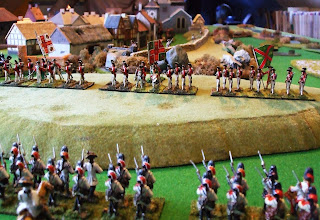Browne had two brigades of regular line infantry (8 battalions), 4 battalions of grenadiers and two battalions of Croats. In addition he had one regiment of Horse Grenadiers and two light battalion guns. Charles' forces were more numerous, but varied in quality from grenadiers to second rate line. In the pictures you will see that French, Swiss, Irish and Saxons played the part of the joint Neapolitan/Spanish army. The activation of the bulk of Charles' force (and him as well) was decided by a dice roll and just for extra spice, the umpire threw a few unexpected twists into the mix.
We began with Browne's force almost at the gates of Velletri, having routed a unit of cavalry back into the town. On a ridge close to the gate were the battalions of Irish in Spanish service. Browne decided to attack them with his grenadiers and then move his line battalions round their flank and into the town. Perhaps this was his first mistake as it meant his best troops were not leading the attack. However, forward went the grenadiers against the Irish. To the left of the Irish was a unit of Dragoons, to prevent them interfering in the infantry action Browne ordered his Horse Grenadiers to attack them. This they did, pushing the Spanish horse back into the broken ground below the walls of the town. Just as the Austrian cavalry commander was reforming his men ready to attack the flank of the Irish foot, he was informed by an aide that the Spanish horse had returned, and were now moving around his flank. Changing face again the Horse Grenadiers re-engaged in melee with the Spanish and although they had the best of the ensuing fight they were drawn away from the main action for some time.
The first unit through the gate at Velletri was one of the Croat battalions, closely followed by the second. Browne's orders had been specific; one battalion was to advance down the main street, the second on the street to the right. Both units were to make a swift march and meet at the town hall, where Charles was reported to have set up his headquarters. If possible they were to seize Charles and hold the building until reinforcements arrived. March discipline as far as the gate to Velletri had been excellent, but once inside the gate, some men took the opportunity to slope off in search of plunder. (This was one of the umpire's 'extra's'). With numbers reduced by 25% the Croats moved forward. Now a second 'extra' was revealed. Some rather reckless plundering had started a fire. Alarmed, residents took it upon themselves, to start firing at the men in the streets, assuming they were the enemy. Detachments would have to be allocated to 'suppress' these locals.
The Croat unit which was to advance down the street to the right of the main street became emeshed in a fight with elements of the town watch and a light battery which was covering the gate.
At this point the dice favoured the Spanish/Neapolitan commander as both the reserve brigades, plus the grenadiers passed their activation test. So troops began moving to seal off the Austrian attack. Dice also roused Charles from his cups, the Mayor of Velletri, being the proud owner of an excellent cellar; (at least until yesterday). Helped by his aides and pausing only to empty the last goblet, Charles joined his escort of Hussars and galloped off down the street as the first element of the Croats approached the Town Hall. The bird had flown, but Browne didn't know that and continued to feed men into the town. He was hampered by the determined resistance of the Irish battalions. They had driven off one grenadier battalion with over 50% losses and were trading volleys with the other three. One of the Irish battalions was driven off the ridge by a determined charge by the Austrians, but that battalion then suffered heavy losses from a devastating volley and had to fall back. The balance was pushed in the Austrian favour by the eventual return of the Horse Grenadiers. They charged one of the Irish battalions from the rear and destroyed them. Reforming, they faced the final Irish battalion, now much reduced in numbers. An officer rode forward under a white flag with the intention of offering the gallant Irish terms. He offer was rejected with disdain by the knot of men gathered round the battalion colours. They stood their ground, firing a weak volley as the horsemen moved forward, but although they fought like demons the action was a foregone conclusion. For the Austrians it was a Phyrric victory. The grenadiers battalions had suffered heavy casulaties and would take no further part.
In the town pressure was increasing on the Austrians. A brigade of Spanish troops, including grenadiers was advancing up the main street. To their right another brigade, supported by a heavy battery was threatening to capture the gate and trap the Austrian units. To the left of the main street a third brigade was threatening the Croats tackling the town watch and light battery.
When Browne reached the gate he realised that the game was up. He ordered the units to fall back in an orderly manner. However, by the time the last units fell back pressure meant that order was lost and Spanish pursuit was only checked by the Horse Grenadiers.





No comments:
Post a Comment